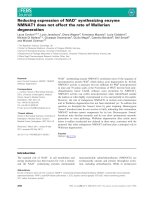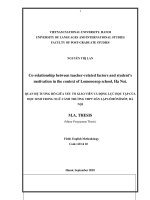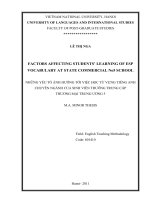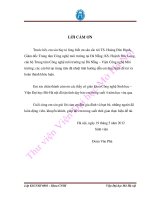Limiting Factors Affect The Rate Of Plants Photosynthesis (1)
Bạn đang xem bản rút gọn của tài liệu. Xem và tải ngay bản đầy đủ của tài liệu tại đây (3.25 MB, 27 trang )
Group 1
Limiting Factors
affect the Rate
of Plant’s
Photosynthesis
Outline of the Presentation
I.
II.
III.
• Introduce Photosynthesis process of
plants
• Light Intensity
• Temperature
• Concentration of Carbon Dioxide
• Conclusion
I. Introduction
1. Photosynthesis process of plants
Light
Advancing Chemical Sciences
2. Limiting Factors
*The law of limiting factors states that:
At any point in time, one of other factors will be in low
supply and limit the rate of photosynthesis. Thus, the
factor in lowest supply is called the limiting factor.
*Limiting factors that affects the rate of photosynthesis:
Light Intensity
Temperature
CO2 Concentration
*Rate of photosynthesis: describe how much sugar and oxygen a plant
can produce over time.
II. Limiting factors affecting the rate
of plant’s photosynthesis
1. Light Intensity
/>
*Stoma (khí khổng): is a pore, found in the epidermis (biểu bì) of
leaves that is used to control gas exchange.
Chlorophyll
www.bbc.co.uk
*Chlorophyll( chất diệp lục): a green pigment (sắc tố) found in
chloroplasts (lạp lục), present in all green plants.
iweb.langara.bc.ca
*Chloroplast ( lạp lục): tiny factories inside the cells of plants. It takes
the energy from the sunlight and use it to make plant food.
[rate of photosynthesis]
O
From O to A, as light
intensity increases, the
photosynthetic
rate also increase.
Light intensity is a
limiting
A
factor during this stage.
B
From A to B (saturated
point),
eventhough light intensity
increases, rate of
photosynthesis
remains constant. Light
intensity
is no longer a limiting
factor.
2. Temperature
.
250C
* Temperature speeds up all chemical reactions.
* The temperature increases => the enzymes get
more energy and the rate of photosynthesis increases.
* Enzyme: protein that act as catalysts (chất xúc tác) within cells.
.
250C
*250C is the optimal temperature.
*At that temperature, the enzyme is most efficient.
.
250C
*The temperature is higher than 250C => the rate
of photosynthesis falls rapidly.
*The enzymes are denatured.
*Denatured (biến dạng): change the shape
Why are the enzymes
denatured in high
temperature
(over 25 C) ?
0
*Enzymes and denatured process
.
*Substrate (chất nền): In this case, the two substrates for
photosynthesis are carbon dioxide (CO2) and water (H2O).
*Denaturing enzymes
.
.
The enzyme is denatured at 450C.
The rate of photosynthesis stops entirely.
3. Concentration of CO2
0.03-0.04%
0.03-0.04%
/>
*CO2 diffusion process
0.03-0.04%
*Diffusion (khuếch tán): the tendency of molecules to spread out in
available space.
/>%20limiting%20factors.pdf
/>
0.03-0.04%
CO2
PR
Certain C02
concentration
=> Photosynthesis stays
constant
PR: photosynthesis rate
0.03-0.04%
III. Conclusion
- Photosynthesis is the one of the most important
processes which supplies oxygen and gives off carbon
dioxide to our life.
- Photosynthesis process is directly dependent on the
supply
of
temperature,
light
intensity,
and
concentration of carbon dioxide. Limiting any one of
these factors can limit the rate of photosynthesis.
- With knowledge of limiting factors, it is possible to
control the growing conditions for crop plants. This
enables faster growing of plants and the increase of their
quality and yield.









